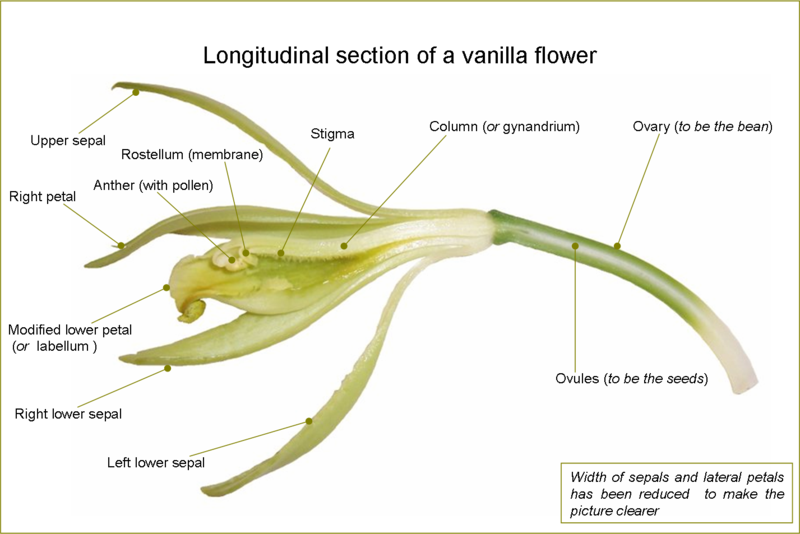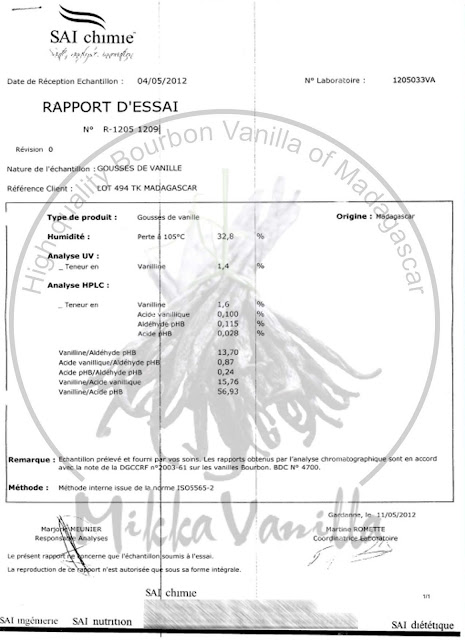 The main species harvested for vanillin is Vanilla planifolia. Although it is native to Mexico, it is now widely grown throughout the tropics. Madagascar is the world's largest producer. Additional sources include Vanilla pompona and Vanilla tahitiensis (grown in Tahiti and Niue), although the vanillin content of these species is much less than Vanilla planifolia.
The main species harvested for vanillin is Vanilla planifolia. Although it is native to Mexico, it is now widely grown throughout the tropics. Madagascar is the world's largest producer. Additional sources include Vanilla pompona and Vanilla tahitiensis (grown in Tahiti and Niue), although the vanillin content of these species is much less than Vanilla planifolia.Vanilla grows as a vine, climbing up an existing tree (also called a tutor), pole, or other support. It can be grown in a wood (on trees), in a plantation (on trees or poles), or in a "shader", in increasing orders of productivity. Its growth environment is referred to as its terroir and includes not only the adjacent plants, but also the climate, geography and local geology. Left alone, it will grow as high as possible on the support, with few flowers. Every year, growers fold the higher parts of the plant downwards so that the plant stays at heights accessible by a standing human. This also greatly stimulates flowering.
The distinctively flavored compounds are found in the fruit, which results from thepollination of the flower. One flower produces one fruit. Vanilla planifolia flowers arehermaphroditic: they carry both male (anther) and female (stigma) organs; however, to avoid self-pollination, a membrane separates those organs. The flowers can only be naturally pollinated by a specific Melipone bee found in Mexico (abeja de monte ormountain bee). This bee provided Mexico with a 300 year long monopoly on Vanilla production, from the time it was first discovered by Europeans and the French first transplanted the vines to their overseas colonies, until a substitute was found for the bees. The vines would grow, but would not fruit outside of Mexico. Growers tried to bring this bee into other growing locales, to no avail. The only way to produce fruits without the bees is artificial pollination. And today, even in Mexico, hand pollination is used extensively.
In 1836, botanist Charles François Antoine Morren was drinking coffee on a patio in Papantla (in Veracruz, Mexico) and noticed black bees flying around the vanilla flowers next to his table. He watched their actions closely as they would land and work their way under a flap inside the flower, transferring pollen in the process. Within hours the flowers closed and several days later Morren noticed vanilla pods beginning to form. Morren immediately began experimenting with hand pollination. A few years later in 1841, a simple and efficient artificial hand pollination method was developed by a 12-year-old slave named Edmond Albius on Réunion, a method still used today. Using a beveled sliver of bamboo, an agricultural worker lifts the membrane separating the anther and the stigma, then, using the thumb, transfers the pollinia from the anther to the stigma. The flower, self-pollinated, will then produce a fruit. The vanilla flower lasts about one day, sometimes less, and so, growers have to inspect their plantations every day for open flowers, a labor-intensive task.
The fruit, a seed capsule, if left on the plant, will ripen and open at the end; as it dries, the phenolic compounds crystallize, giving the beans a diamond-dusted appearance which the French call givre (hoarfrost). It will then release the distinctive vanilla smell. The fruit contains tiny, flavorless seeds. In dishes prepared with whole natural vanilla, these seeds are recognizable as black specks.
Like other orchids' seeds, vanilla seed will not germinate without the presence of certain mycorrhizal fungi. Instead, growers reproduce the plant by cutting: they remove sections of the vine with six or more leaf nodes, a root opposite each leaf. The two lower leaves are removed, and this area is buried in loose soil at the base of a support. The remaining upper roots will cling to the support, and often grow down into the soil. Growth is rapid under good conditions.
















